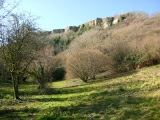![]()
The site maintainer recently visited
Weston Plats, part of a historic but now obsolete East Devon farming system that used the cliffside microclimate to raise early vegetables. The plot has been cleared and restored by the National Trust, and is accessible from the South West Coast Path.
>
View Larger Map
![]() |
| Weston Plats - looking up to Rempstone Rocks |
As Peter Orlando Hutchinson wrote of Branscombe Plats in 1858, historically the cliffs of East Devon provided a market gardening environment of "a beautiful undercliff, a sort of stage, half way down to the sea, well cultivated with corn, potatoes, etc". Geologically, it's a ledge formed by the upper surface of Triassic rocks, with Cretaceous crags above. This provided a sheltered microclimate used to raise early young potatoes, early daffodils, crocuses, tulips, broad beans and strawberries. It made arduous farming, but was economically worthwhile until the 1940s, when potato production there had been badly hit by potato eelworm; cheap imports have long since made it obsolete.
![]() |
| Rempstone Rocks - Weston Plats are below, to the left |
Weston Plats, one of these plots a couple of miles east of Sidmouth, was recently cleared and restored in a joint project between the National Trust and the East Devon Area of Outstanding Natural Beauty. Half-way up the cliff, it can be accessed either via the South West Coast Path, or by a slightly less strenuous walk from the Donkey Sanctuary via Dunscombe Coppice. It's worth visiting, just for the scenery - it's a secluded and relaxing place, sheltered below the chalk crags of Rempstone Rocks - but there are also oddments of agricultural equipment to see, and a reconstructed storage shed (a "linhay").
For further background, see the National Trust page - The past rediscovered: The Weston Plats. The South West Coast Path site has a page - Weston Plats - giving detailed instructions on visiting.
- RG
 The site maintainer recently visited Weston Plats, part of a historic but now obsolete East Devon farming system that used the cliffside microclimate to raise early vegetables. The plot has been cleared and restored by the National Trust, and is accessible from the South West Coast Path. >
The site maintainer recently visited Weston Plats, part of a historic but now obsolete East Devon farming system that used the cliffside microclimate to raise early vegetables. The plot has been cleared and restored by the National Trust, and is accessible from the South West Coast Path. >
